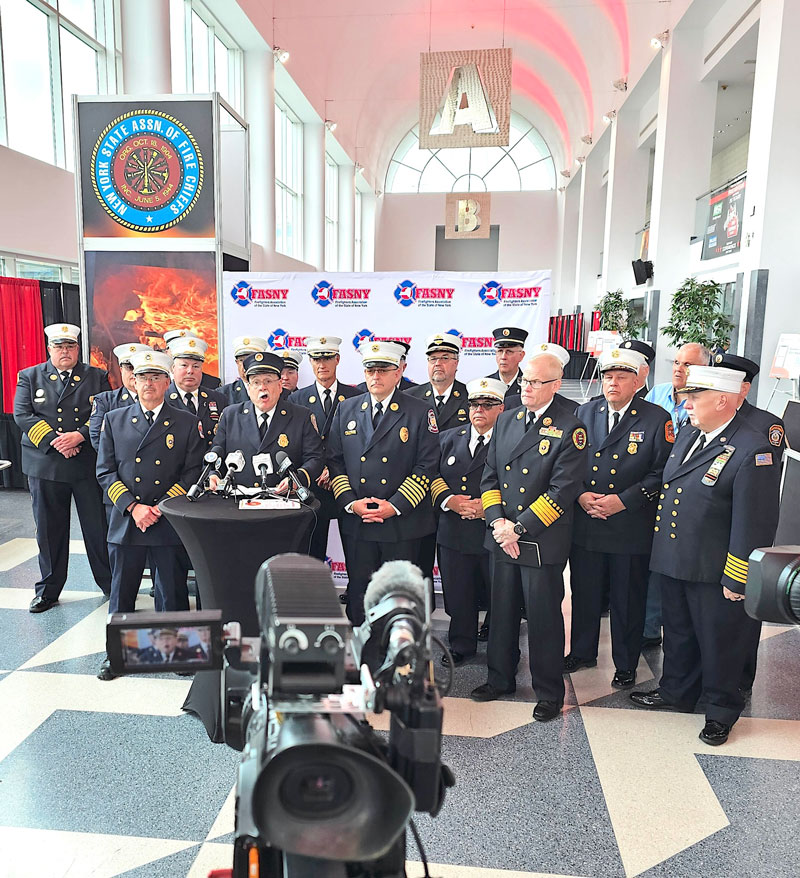
Joe LoTemplio
The Press-Republican, Plattsburgh, N.Y.
(TNS)
PLATTSBURGH — A proposal for new stringent regulations overseeing local fire departments and emergency services providers could put some units out of business.
“I do want to stress we’re not talking about compromising safety. We’re talking about rules and regulations that are just not attainable to our local volunteer fire departments and EMS fighters,” State Assemblyman D. Billy Jones (D-Chateaugay Lake) said.
“It’s too much.”
FINANCIAL BURDEN
Jones was joined by Scott Ewing, the past president of the New York Fire Coordinators Association; Eric Day, Clinton County Emergency Services director and vice president of the NYS Fire Coordinators Association; and several other first responders at a news conference Wednesday at the South Plattsburgh fire station.
The group explained that regulations being proposed by the federal Occupation Safety and Health Administration would require volunteer and paid fire departments and EMS providers to make significant changes.
More training, newer vehicles and equipment, more inspections, more paperwork and other requirements would drive up costs for departments, put an added burden on members’ time commitments, affect recruitment and retention, could drive up insurance costs and ultimately could lengthen response times.
“The more paperwork they do, the less time they get going out training and actually doing these jobs that we depend on them for and it’s going to put such a financial burden on these fire departments, our local towns, villages and fire districts that they just can’t carry the load,” Jones said.
COSTLY REQUIREMENTS
Purchasing new washers and dryers for fire houses with new ventilated systems that would be required could cost as much as $125,000, Jones said, as an example of what the impact of the new regulations could be.
Ewing said physicals for volunteers could go from $250 to as much as $1,400, depending on who provides the service.
Fire trucks, which can cost between $800,000 and $1.5 million would also have to be turned over every 15 years, and it can take three to four years to order a truck, have it built to order and delivered.
“That’s a huge undertaking for most of the agencies that are out there,” Ewing said.
“I can’t stress enough how this is going to change each one of these departments. It’s going to change them significantly.”
Day noted that under the proposed training requirements, most sitting fire chiefs in the state would not be qualified to hold their positions.
“There is probably only one or two people, not including me, in this county that would meet the standards that are in this proposal,” he said.
Jones, Ewing and Day stressed that they recognize the need for an update in the regulations, which have not been updated since the early 1980s. But they believe what is being proposed is too much for small departments to handle, and that the bulk of changes on the table were designed with larger departments from bigger metropolitan areas in mind.
Ewing said the proposed changes take up a document of 609 pages.
“The sheer volume of all the material is overwhelming for an already taxed fire emergency management system,” Ewing said.
“We’re asking OSHA to allow emergency services to have a seat at the table to allow us to work with them on producing a document that everybody can (adjust to). OSHA has designated a one-size-fits-all standard that does not reflect unique challenges and capacities.”
SAFETY VITAL
Jones said that regardless, no one wants to sacrifice safety.
“Our number one priority is making sure that these ladies and gentlemen who go out as first responders come back home to their families,” he said.
“We are not talking about impeding on safety here.”
Day agreed.
“We can’t say enough about safety. We’re not arguing with safety,” Day said.
“The Fire Service agrees that there needs to be an update, but the proposed update is just a little bit too much on a lot of these departments.”
RECRUITMENT, RETAINING
Burdensome regulations would also hurt recruitment of volunteers and retaining those that are already serving.
Jones said if fire departments cannot keep staffing levels up, some municipalities may have to consider paid fire departments, which could be costly for residents.
“If we keep pushing towards this stuff and the domino effect, and we don’t retain our volunteer fire departments, you know what that means? Paid fire departments,” he said.
“I’ve said this 10,000 times before, the New York state taxpayer, or the taxpayer across this country, does not want to see their tax bill go up like it has in every community that has paid fire department personnel.”
Jones and his fellow fire department and EMS supporters are encouraging the public to let OSHA know how they feel about the proposed regulations and the potential impact they could have on local units.
The Federal Register is accepting comments until July 22. They will then consider the comments before making any decisions.
Comments can be sent to tinyurl.com/2crz2bsy.
Ewing said local fire and EMS officials as well as Jones and others have also been in contact with the state’s Congressional delegation of Sens. Charles Schumer and Kirsten Gillibrand and Congresswoman Elise Stefanik who also support a compromise to the proposed regulations.
___
(c)2024 the Press-Republican (Plattsburgh, N.Y.)
Visit the Press-Republican (Plattsburgh, N.Y.) at pressrepublican.com
Distributed by Tribune Content Agency, LLC.

